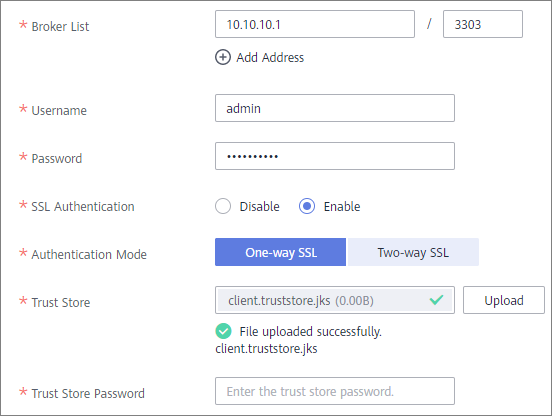Connecting to an ActiveMQ Data Source
Overview
ROMA Connect can use ActiveMQ as a data source for data integration tasks. Before using the ActiveMQ data source, you need to connect it to ROMA Connect.
Prerequisites
Each connected data source must belong to an integration application. Ensure that an integration application is available before connecting a data source, or create one first.
Procedure
- Log in to the ROMA Connect console. On the Instances page, click View Console of an instance.
- In the navigation pane on the left, choose Data Sources. In the upper right corner of the page, click Access Data Source.
- On the Default tab page, select ActiveMQ and click Next.
- Configure the data source connection information.
Table 1 Data source connection information Parameter
Description
Name
Enter a data source name. Using naming rules facilitates future search.
Encoding Format
Default: utf-8
Integration Application
Select the integration application to which the data source belongs.
Description
Enter a brief description of the data source.
Broker List
Enter the broker connection address of ActiveMQ, that is, the IP address and port number of the host. Click Add Address to add addresses.
Username
Enter the username for connecting to ActiveMQ.
Password
Enter the password for connecting to ActiveMQ.
SSL Authentication
Determine whether to use SSL authentication for the connection between ROMA Connect and ActiveMQ.
Authentication Mode
This parameter is mandatory only if SSL Authentication is set to Enable.
Select the SSL authentication mode.
- One-way SSL: Only the client (ROMA Connect) authenticates the server (ActiveMQ).
- Two-way SSL: The client (ROMA Connect) and server (ActiveMQ) authenticate each other.
Trust Store
This parameter is mandatory only if SSL Authentication is set to Enable.
This parameter specifies the trust store used by the client during SSL authentication. It must match the private key used by the server.
Trust Store Password
This parameter is mandatory only if SSL Authentication is set to Enable.
Enter the password of the trust store.
Keystore
This parameter is mandatory only if SSL Authentication Mode is set to Two-way SSL.
This parameter specifies the keystore used by the client during SSL two-way authentication. It must match the public key used by the server.
Keystore Password
This parameter is mandatory only if SSL Authentication Mode is set to Two-way SSL.
Enter the password of the keystore.
Keystore Key Password
This parameter is mandatory only if SSL Authentication Mode is set to Two-way SSL.
Enter the password of the keystore key. If this parameter is not specified, the keystore key password is the same as the keystore password.
The following is an example of connecting to an ActiveMQ in one-way SSL authentication mode. You need to upload the trust store.
- Click Check Connectivity to check the connectivity between ROMA Connect and the data source.
- If the test result is Data source connected successfully, go to the next step.
- If the test result is Failed to connect to the data source, check the data source status and connection parameters, and click Recheck until the connection is successful.
- Click Create.
Feedback
Was this page helpful?
Provide feedbackThank you very much for your feedback. We will continue working to improve the documentation.See the reply and handling status in My Cloud VOC.
For any further questions, feel free to contact us through the chatbot.
Chatbot






